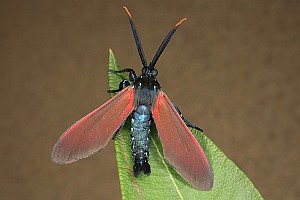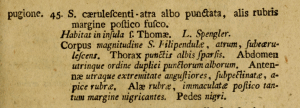

 +8Kontinente:EUNAKI
+8Kontinente:EUNAKI1. Lebendfotos
1.1. Falter
2. Diagnose
2.1. Erstbeschreibung
2.2. Beschreibung als Empyreuma affinis
3. Biologie
3.1. Nahrung der Raupe
Weller et al. (2004: 28) fassen zu ihren untersuchten Empyreuma-Arten zusammen: "Notes on Biology. Larvae of these species have been reared on Nerium oleander (Apocynaceae) based on museum labels. The plant genus Nerium has only three species, and is native from the Mediterranean to Japan. The exotic species, N. oleander has been naturalized widely in North America (Correll & Johnston 1979) and it contains cardiac glycosides. The native hosts of Empyreuma have not been recorded, but potential New World apocyanaceous host genera include Thevetia L., Plumeria L., Mandevilla Lindl., and Tabernaemontana L.."
4. Weitere Informationen
4.1. Andere Kombinationen
- Sphinx pugione Linnaeus, 1767 [Originalkombination]
4.2. Synonyme
- Sphinx lichas Cramer, [1776]
- Empyreuma lichas (Cramer, [1776]
- Chrysaor erythropterus Hübner, 1808
- Empyreuma mucro Zerny, 1912
- Empyreuma sanguinea Rothschild, 1912
- Empyreuma affinis Rothschild, 1912 [synonymisiert von Weller et al. (2004)
- Empyreuma haytiensis Forbes, 1917
4.3. Taxonomie
Die Vorkommen auf Kuba galten lange Zeit als eigene Art: Empyreuma affinis. Weller et al. (2004: 24) kamen bei einer genetischen und (genital-)morphologischen Studie zum Schluss: "Both morphological and moleeular results support plaeing E. affinis as a junior synonym of E. pugione."
4.4. Faunistik
Linnaeus (1767: 807) teilte mit: "Habitat in insula S. Thomae". Damit war sicher nicht die gleichnamige Ilha de São Tomé in Westafrika gemeint, sondern St. Thomas Island (Virgin Islands, Amerikanische Jungferninseln), wo die Art noch immer vorkommt.
Weller et al. (2004: 24) meldeten von ihnen untersuchte Belegexemplare aus Kuba (viele Fundorte), der Dominikanischen Republik, den Kayman-Inseln, Gouadeloupe und Haiti. Nach der [mothphotographersgroup.msstate.edu] wurde die Art auch in Puerto Rico und vielen küstennahen Bereichen von Florida (USA) gefunden.
Agassiz et al. (2013: 112) führen "Empyreuma affinis" bei den "adventive species" und schreiben zu England: "Imported from Florida with beer kegs Wiltshire, 1990: (Clancy et al., 2012: 592). North American."
(Autor: Erwin Rennwald)
4.5. Literatur
- Agassiz, D.J.L., Beavan, S.D. & R.J. Heckford (2013): Checklist of the Lepidoptera of the British Isles. - Royal Entomological Society. 206pp.
- Erstbeschreibung: Linnaeus, C. (1767): Systema Naturae, Tom. I. Pars. II. Editio duodecima reformata. 533-1327 + unpaginierter Anhang. Holmiae (Salvius).
- Beschreibung als Empyreuma affinis: Rothschild, W. (1912): New Syntomidae. — Novitates Zoologicae 19 (2): 151-186.
- Weller, S.J., Simmons, R.B. & A.L. Carlson (2004): Empyreuma species and species limits: evidence from morphology and molecules (Arctiidae). — Journal of Lepidopterists Society, 58 (1): 1-32. [PDF auf images.peabody.yale.edu]













